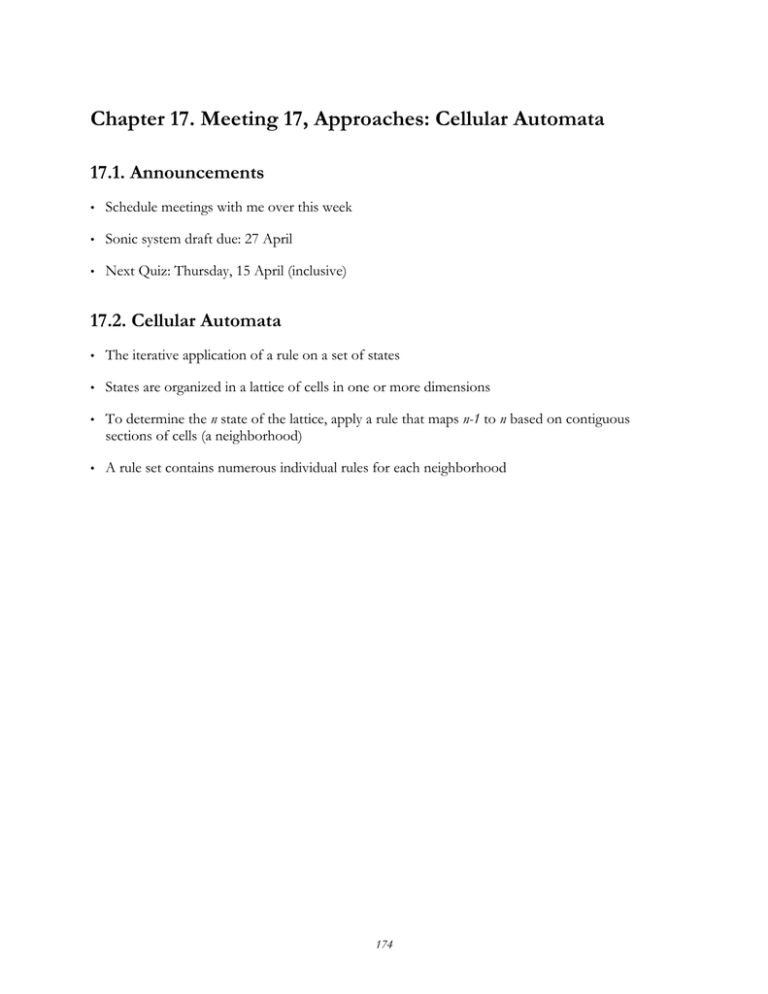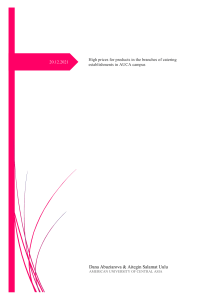
Chapter 17. Meeting 17, Approaches: Cellular Automata
17.1. Announcements
•
Schedule meetings with me over this week
•
Sonic system draft due: 27 April
•
Next Quiz: Thursday, 15 April (inclusive)
17.2. Cellular Automata
•
The iterative application of a rule on a set of states
•
States are organized in a lattice of cells in one or more dimensions
•
To determine the n state of the lattice, apply a rule that maps n-1 to n based on contiguous
sections of cells (a neighborhood)
•
A rule set contains numerous individual rules for each neighborhood
174
© Wikipedia user:Kyber and Wikimedia Foundation. License CC BY-SA. This content is excluded
from our Creative Commons license. For more information, see http://ocw.mit.edu/fairuse.
•
CA are commonly described as having four types of behavior (after Wolfram): stable
homogeneous, oscillating or patterned, chaotic, complex
17.3. CA History
•
1966: John von Neimann demonstrates a 2D, 29-state CA capable of universal computation
•
1971: Edwin Roger Bank demonstrates 2D binary state CA
•
2004: Matthew Cook demonstrates 1D binary state, rule 110 CA
17.4. CA in Music
•
First published studies: Chareyron (1988, 1990) and Beyls (1989)
•
Chareyron: applied CA to waveforms
•
Beyls: numerous studies applied to conventional parameters
•
Xenakis: employed CA in Horos (1986)
175
Mapped CA to a large scale and used active cells to select pitches
17.5. The caSpec
•
String-based notation of CA forms
•
Key-value pairs: key{value}
17.6. CA Types
•
Standard: f{s}
Discrete cell values, rules match cell formations (neighborhoods)
:: auca f{s} 380 0
f{s}k{2}r{1}i{center}x{91}y{135}w{91}c{0}s{0}
:: auca f{s} 379 0
f{s}k{2}r{1}i{center}x{91}y{135}w{91}c{0}s{0}
176
•
Totalistic: f{t}
Discrete cell values, rules match the sum of the neighborhood
:: auca f{t} 37 0
f{t}k{2}r{1}i{center}x{91}y{135}w{91}c{0}s{0}
177
:: auca f{t} 39 0
f{t}k{2}r{1}i{center}x{91}y{135}w{91}c{0}s{0}
178
•
Continuous: f{c}
Real-number cell values within unit interval, rules specify values added to the average of previous
cell formation
:: auca f{c} .8523 0
f{c}k{0}r{1}i{center}x{91}y{135}w{91}c{0}s{0}
•
Float: f{f}
Like continuous, but implemented with floats (it makes a difference)
:: auca f{f} .254 0
f{f}k{0}r{1}i{center}x{91}y{135}w{91}c{0}s{0}
179
17.7. Possible Cell States
•
For f{s,t}: the k value provides the number of possible values
•
For f{c,f}: the k value is zero
•
The k value can be set for discrete CA
:: auca f{s}k{4} 3841 0
f{s}k{4}r{1}i{center}x{91}y{135}w{91}c{0}s{0}
180
17.8. Rules Neighorhood
•
The r number defines the number of cell states taken into account
•
For 1D CA, the neighborhood is 2r+1
•
Half integer fractional values are permitted
•
An r{3} CA
:: auca f{s}r{3} 380 0
f{s}k{2}r{3}i{center}x{91}y{135}w{91}c{0}s{0}
181
17.9. Size, Orientation, and Presentation
•
1D often present 1 horizontal row that wraps, unbound but finite space
•
A table, with cell sites on x axis, time on y values
•
A cylinder
•
Size is given with x, number of evolutions specified with y
:: auca f{s}x{9}y{200} 380 0
f{s}k{2}r{1}i{center}x{9}y{200}w{9}c{0}s{0}
182
:: auca f{s}x{400}y{400} 380 0 f{s}k{2}r{1}i{center}x{400}y{400}w{400}c{0}s{0}
183
•
Can specify a sub-table with a width and a center independent of x axis, time on y values
Width, w{}, is the number of exposed cells
Center, c{}, is center position from which cells are extracted
Skip, s{}, is the number of rows neither displayed nor counter in y.
•
Example: a width is not the same as
:: auca f{s}x{91}y{200}w{4} 381 0
f{s}k{2}r{1}i{center}x{91}y{200}w{4}c{0}s{0}
184
:: auca f{s}x{4}y{200} 381 0
f{s}k{2}r{1}i{center}x{4}y{200}w{4}c{0}s{0}
185
17.10. The Initial Row
•
The init can be specified with an i{} parameter
•
Strings like center (i{c}) and random (i{r}) are permitted
:: auca f{f}i{r} .0201 0
f{f}k{0}r{1}i{random}x{91}y{135}w{91}c{0}s{0}
186
:: auca f{t}i{r} 201 0
f{t}k{2}r{1}i{random}x{91}y{135}w{91}c{0}s{0}
187
•
Numerical sequences of initial values repeated across a row
:: auca f{t}i{010010010} 201 0
f{t}k{2}r{1}i{010010010}x{91}y{135}w{91}c{0}s{0}
17.11. Dynamic Parameters: Rule and Mutation
•
Rule: a floating or integer value
Wolfram offers standard encoding of rules as integers
Out of range rule values are resolved by modulus of total number of rules
•
PO applied to the rule value of CA
:: auca f{s} ig,(bg,rp,(380,533)),(bg,rp,(10,20)) 0 f{s}k{2}r{1}i{center}x{91}y{135}w{91}c{0}s{0}
188
•
Mutation: a unit interval probability
•
PO applied to the mutation of a CA
:: auca f{s} 533 whpt,e,(bg,rp,(8,16,32,64)),0,.01
f{s}k{2}r{1}i{center}x{91}y{135}w{91}c{0}s{0}
189
17.12. Reading: Ariza: Automata Bending: Applications of Dynamic
Mutation and Dynamic Rules in Modular One-Dimensional Cellular
Automata
•
Ariza, C. 2007a. “Automata Bending: Applications of Dynamic Mutation and Dynamic Rules in
Modular One-Dimensional Cellular Automata.” Computer Music Journal 31(1): 29-49. Internet:
http://www.mitpressjournals.org/doi/abs/10.1162/comj.2007.31.1.29.
•
What is automata bending? Why has this not been previously explored?
•
What are the benefits of automata bending for creative applications?
•
“The utility and diversity of CA are frequently overstated”: is this statement warranted?
•
What are some of the problems of using CA that do exhibit emergent
•
What does Wolfram think of float CA. Is he right?
•
Hoffman claims that Xenakis’s use of CA demonstrated “the strength and limitation of universal
computation in music composition”; is this possible?
17.13. Bent Automata
•
Examples
190
:: auca f{s}x{81}y{80}k{2}r{1} 109 0.003 :: auca f{t}x{81}y{80}k{3}r{1} 1842 bpl,e,l,((0,0),(80,.02)) :: auca f{s}x{81}y{80}k{2}r{1}i{r} 90.5 0 :: auca f{t}y{80}x{81}r{1}k{4}i{r}s{20} mv,a{195735784}b{846484}:{a=3|b=1} 0 17.14. Mapping Tables to Single Value Data Streams
•
Combinations of type, axis, source, filter, 60 total possibilities
© MIT Press. All rights reserved. This content is excluded from our Creative Commons license.
For more information, see http://ocw.mit.edu/fairuse.
Source: Ariza, C. Computer Music Journal 31, no. 1 (2007): 29-49.
17.15. The CA as ParameterObject
•
All underlying tools for automata are found in automata.py
•
CaList and CaValue provide high level ParameterObject interfaces
•
CaList returns raw CA values (processed by table extraction) that can be selected from using
common selectors; CaValue normalizes within unit interval and provides dynamic min and max
values
17.16. The CA as a Generator of Melodies
•
Probably the most common approach: use active cell index positions to indicate active positions
of a scale
•
CaList with rule 90 and flatRowIndexActive; a smaller x is used to reduce index values
:: tpmap 100 cl,f{s}x{20},90,0,fria,oc
caList, f{s}k{2}r{1}i{center}x{20}y{135}w{20}c{0}s{0}, (constant, 90),
(constant, 0), flatRowIndexActive, orderedCyclic
TPmap display complete.
191
•
Command sequence using TM Harmonic Assembly:
•
emo m
•
create a single, large Multiset using a sieve
pin a 5@0|7@2,c2,c7
•
tmo ha
•
tin a 27
•
tie r pt,(c,8),(ig,(bg,rc,(2,3)),(bg,rc,(3,6,9))),(c,1)
•
tie a ls,e,9,(ru,.2,1),(ru,.2,1)
•
select only Multiset 0
tie d0 c,0
•
select pitches from Multiset using CaList
tie d1 cl,f{s}x{20},90,0,fria,oc
•
create only 1 simultaneity from each multiset
tie d2 c,1
•
create only 1-element simultaneities
tie d3 c,1
•
•
eln; elh
CaList with rule 90 and flatRowIndexActive; a smaller x is used to reduce index values; adding
mutation
:: tpmap 100 cl,f{s}x{20},90,(ls,e,16,0,.05),fria,oc
caList, f{s}k{2}r{1}i{center}x{20}y{135}w{20}c{0}s{0}, (constant, 90), (lineSegment,
(constant, 16), (constant, 0), (constant, 0.05)),
flatRowIndexActive, orderedCyclic
TPmap display complete.
192
•
CaList with a mixture of rule 90 and rule 42 and flatRowIndexActive; a smaller x is used to reduce
index values; adding mutation
:: tpmap 100 cl,f{s}x{20},(ig,(bg,rp,(90,42)),(bg,rp,(2,3))),0,fria,oc
caList, f{s}k{2}r{1}i{center}x{20}y{135}w{20}c{0}s{0}, (iterateGroup, (basketGen,
randomPermutate, (90,42)), (basketGen, randomPermutate, (2,3))),
(constant, 0), flatRowIndexActive, orderedCyclic
TPmap display complete.
17.17. The CA as a Generator of Rhythms
•
Narrow regions of bent CA offer interesting variation of few values
•
A a narrow width of a CA
:: auca f{s}k{2}r{1}x{81}y{120}w{6}c{0}s{0} 109 0
f{s}k{2}r{1}i{center}x{81}y{120}w{6}c{0}s{0}
193
•
A a narrow width of a CA with a small constant mutation
:: auca f{s}k{2}r{1}x{81}y{120}w{6}c{0}s{0} 109 .05
f{s}k{2}r{1}i{center}x{81}y{120}w{6}c{0}s{0}
•
Using CaTable and sumRowActive, we can get a dynamic collection of small integer values
194
:: tpmap 100 cl,f{s}k{2}r{1}x{81}y{120}w{6}c{0}s{0},109,.05,sumRowActive,oc
caList, f{s}k{2}r{1}i{center}x{81}y{120}w{6}c{0}s{0}, (constant, 109), (constant,
0.05), sumRowActive, orderedCyclic
TPmap display complete.
•
Using CaValue and sumRowActive with a different center, we can get a dynamic collection of
floating point values
:: tpmap 100 cv,f{s}k{2}r{1}x{81}y{120}w{6}c{8}s{0},109,.05,sumRowActive,.2,1
caValue, f{s}k{2}r{1}i{center}x{81}y{120}w{6}c{8}s{0}, (constant, 109), (constant, 0.05), sumRowActive, (constant, 0.2), (constant, 1),
orderedCyclic
TPmap display complete.
•
Command sequence using TM Harmonic Assembly:
•
emo mp
•
tin a 47
•
set the multiplier to the integer output of CaList
tie r pt,(c,4),(cl,f{s}k{2}r{1}x{81}y{120}w{6}c{0}s{0},109,.05,sumRowActive,oc),(c,1)
•
set the amplitude to the floating potin output of CaValue
tie a cv,f{s}k{2}r{1}x{81}y{120}w{6}c{8}s{0},109,.05,sumRowActive,.2,1
•
eln; elh
195
17.18. Reading: Miranda: On the Music of Emergent Behavior: What
Can Evolutionary Computation Bring to the Musician?
•
Miranda, E. R. 2003. “On the Music of Emergent Behavior: What Can Evolutionary
Computation Bring to the Musician?.” Leonardo 36(1): 55-59.
•
Miranda claims that “the computer should neither be embedded with particular models at the
outset nor learn from carefully selected examples”; is this possible, and is this achieved with his
model?
•
What is the basic mapping of CAMUS?
Courtesy of MIT Press. Used with permission.
•
What is the basic mapping of Chaosynth?
•
What does Miranda mean when he states that “none of the pieces cited above were entirely
automatically generated by the computer”; is this possible?
196
MIT OpenCourseWare
http://ocw.mit.edu
21M.380 Music and Technology: Algorithmic and Generative Music
Spring 2010
For information about citing these materials or our Terms of Use, visit: http://ocw.mit.edu/terms.






